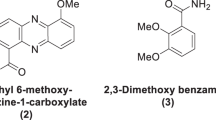Abstract
Group A streptococci strains were grown in broth containing subminimal inhibitory concentrations of chloramphenicol, erythromycin and penicillin, and tested for possible changes in colonial morphology, activity and amount of cellular and extracellular components. The following components were tested: T protein, M protein, opacity factor, lipoteichoic acid, hyaluronic acid, streptolysin S, streptolysin O, DNase, hyaluronidase and NADase. Sub-MICs of these drugs produced variable changes in the bacteria. They increased the amount of hyaluronic acid and hyaluronidase, decreased the amount of M protein, and enhanced phagocytosis and the release of lipoteichoic acid. The results indicate that sub-MICs of chloramphenicol, erythromycin and penicillin may affect the pathogenicity and toxinogenicity of group A streptococci.
Similar content being viewed by others
References
Lorian, V.: Effects of subminimum inhibitory concentrations of antibiotics on bacteria. In: Lorian, V. (ed.): Antibiotics in laboratory medicine. Williams and Wilkins, Baltimore, 1980, p. 342–408.
Lorian, V.: Some effects of subinhibitory concentrations of penicillin on the structure and division of staphylococci. Antimicrobial Agents and Chemotherapy 1975, 7: 864–870.
Lorian, V., Atkinson, B.: Abnormal forms of bacteria produced by antibiotics. American Journal of Clinical Pathology 1975, 64: 678–688.
Sandberg, T. K., Stenquist, K., Svanborg Eden: Effects of sub-MIC of ampicillin, chloramphenicol and nitro-furantoin on the attachment ofEscherichia coli to human uroepithelial cells in vitro. Reviews of Infectious Diseases 1979, 1: 338–844.
Tylewska, S., Hjerten, S., Wadstrom, T.: Effect of subinhibitory concentrations of antibiotics on the adhesion ofStreptococcus pyogenes to pharingeal epithelial cells. Antimicrobial Agents and Chemotherapy 1981, 20: 563–566.
Lorian, V., Atkinson, B.: Effect of serum and blood onEnterobacteriaceae grown in the presence of sub-MIC of ampicillin and mecillinam. Reviews of Infectious Diseases 1979, 1: 797–806.
Gemmel, C. G., Peterson, P. K., Schmeling, D., Kim, Y., Mathews, J., Wannamaker, L., Quie, P. G.: Potentiation of opsonization and phagocytosis ofStreptococcus pyogenes following growth in the presence of clindamycin. Journal of Clinical Investigation 1981, 67: 1249–1256.
Lorian, V., Valuschka, A., Popoola, B.: Pneumococcal beta-hemolysis produced under effect of antibiotics. Applied Microbiology 1973, 25: 290–294.
Sypherd, P. S., Strauss, N., Treffers, H. P.: The preferential inhibition by chloramphenicol of induced enzyme synthesis. Biochemistry and Biophysics Research Communication 1962, 7: 477–481.
Gemmell, C. G., Amir, M. K. A.: Effects of certain antibiotics on the formation of cellular antigens and extracellular products by group A streptococci. In: Parker, M. T. (ed.): Pathogenic streptococci. Reedbooks, London, 1979, p. 67–68.
Michel, J., Stessman, P., Stessman, J.: Effect of subminimal concentrations of erythromycin, clandamycin and pristinamycin on the penicillinase production ofStaphylococcus aureus. Antimicrobial Agents and Chemotherapy 1980, 17: 13–15.
Michel, J., Jacobs, J., Sacks, T.: Bactericidal synergistic effect due to chloramphenicol induced inhibition of staphylococcal penicillinase. Chemotherapy 1977, 23: 32–36.
Ferne, M., Bergner-Rabinowitz, S., Duchan, Z., Michel, J.: Morphologic and enzymatic changes of beta-hemolytic group A streptococci due to sub-MIC of chloramphenicol, erythromycin and penicillin. In: Holm, S. E., Christensen, P. (ed.): Basic concepts of streptococci and streptococcal diseases. Reedbooks, London, 1981, p. 148–150.
Williams, R. E. D.: Laboratory diagnosis of streptococcal infections. Bulletin of the World Health Organization 1958, 19: 153–176.
Griffith, F.: The serological classification ofStreptococcus pyogenes. Journal of Hygiene 1934, 34: 542–584.
Ofek, J., Fleiderman, S., Bergner-Rabinowitz, S., Ginsburg, I.: Application of enzyme production properties in subtyping of group A streptococci according to T type. Applied Microbiology 1971, 22: 748–751.
Sela, M. N., Lahav, M., Ginsburg, I.: The effect of leukocyte hydrolases on bacteria. IX. Inflammation 1977, 2: 151–164.
Moskowitz, M.: Separation of properties of a red cell sensitizing substance from streptococci. Journal of Bacteriology 1966, 91: 2200–2204.
Bitter, T., Muir, H. M.: A modified uronic acid carbazole reaction. Annals of Biochemistry 1962, 4: 330–334.
Bernheimer, A. W.: Formation of bacterial toxin (streptolysin S) by resting cells. Journal of Experimental Medicine 1949, 90: 373–392.
Ginsburg, I., Bentwich, Z.: Effect of cystein on the formation of streptolysin S by group A streptococci. Proceedings of the Society of Experimental and Biological Medicine 1964, 117: 670–675.
Havlicek, J.: Determination of ASO. WHO International Reference Center for Streptococcus Typing, Prague, 1976.
Nelson, J. E., Ayonb, M., Wannamaker, L. W.: Streptococcal ADNB: microtechnique determination. Journal of Laboratory and Clinical Medicine 1968, 71: 867–873.
Watanabe, N.: Antihyaluronidase level in children with rheumatic fever and other streptococcal infection. Japanese Heart Journal 1976, 17: 580–591.
Faber, V., Rosendal, K.: Streptococcal hyaluronidase II. Acta Pathologica et Microbiologica Scandinavica 1954, 35: 159–164.
Home, D., Tomasz, A.: Tolerant response ofStreptococcus sanguis to beta lactamase and other cell wall inhibitors. Antimicrobial Agents and Chemotherapy 1977, 11: 888–896.
Efrati, H., Sacks, T., Ne'eman, N., Lahav, M., Ginsburg, I.: The effect of leukocyte hydrolases on bacteria. Inflammation 1976, 1: 371–407.
Ginsburg, I.: Mechanism of cell and tissue injury induced by group A streptococci: relation to post-streptococcal sequelae. Journal of Infectious Diseases 1972, 126: 294–456.
Author information
Authors and Affiliations
Rights and permissions
About this article
Cite this article
Michel, J., Ferne, M., Borinski, R. et al. Effects of subminimal inhibitory concentrations of chloramphenicol, erythromycin and penicillin on group A streptococci. Eur. J, Clin. Microbiol. 1, 375–380 (1982). https://doi.org/10.1007/BF02019938
Issue Date:
DOI: https://doi.org/10.1007/BF02019938




